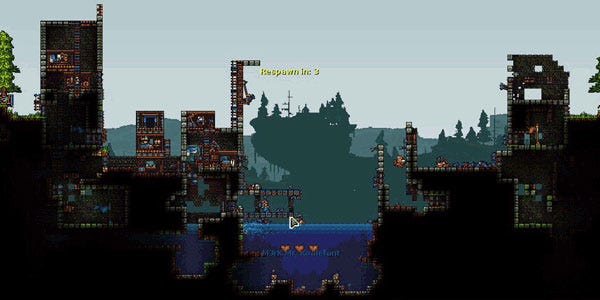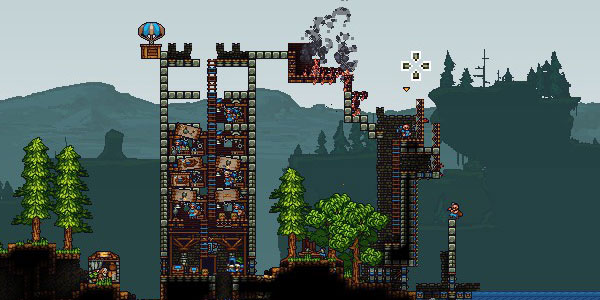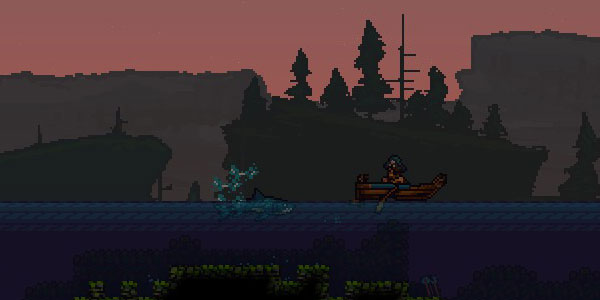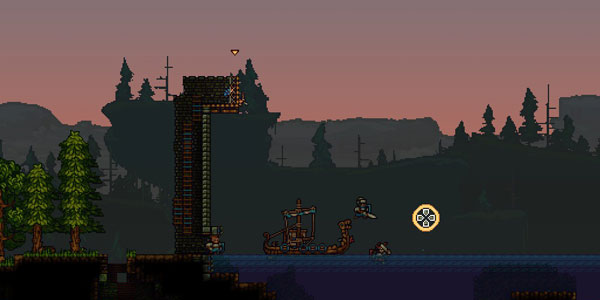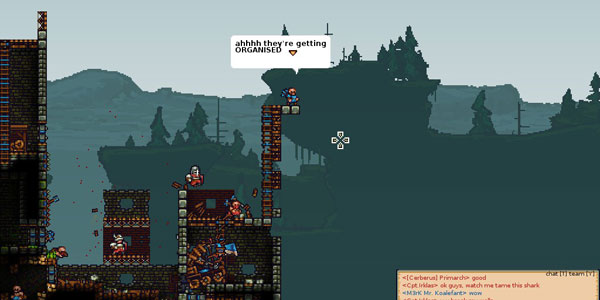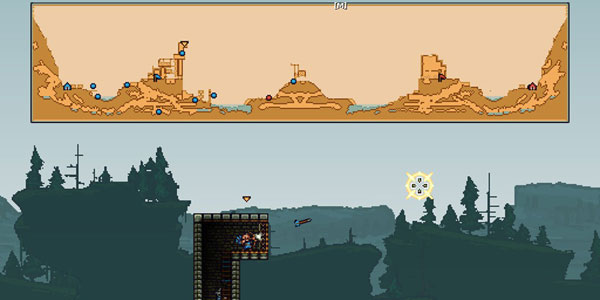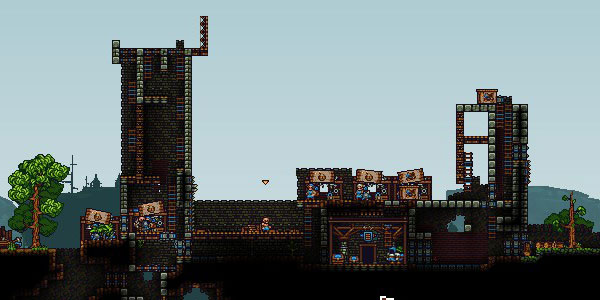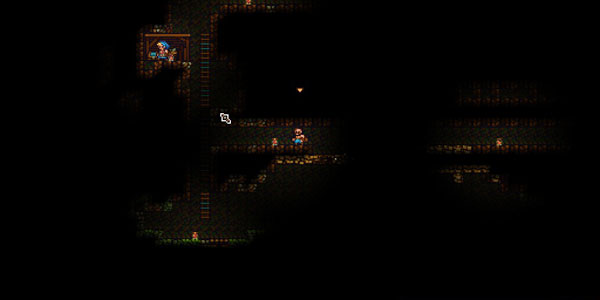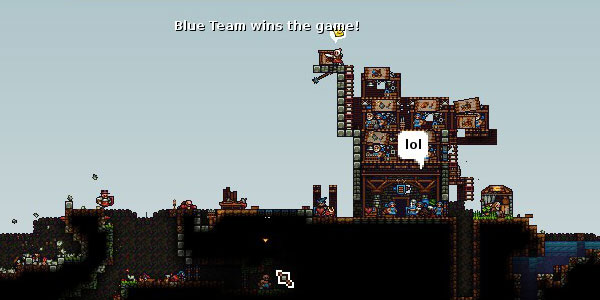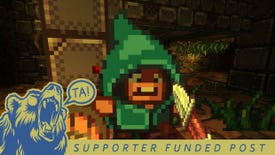Wot I Think: King Arthur's Gold
A beautiful castle
King Arthur’s Gold has been knocking about for years, quietly existing in the shadow of similar games like Terraria, Minecraft and Ace of Spades. In that time the creators (those who brought you Soldat) have been chipping away and sculpting an unassuming yet heroic little game of insane siege warfare. Now that it has taken its complete form and has been deemed beautiful enough for Steam, it is finally time to give this medieval muckabout some of the attention it deserves. Here’s Wot I Think.
To start, I think it is just super. The premise is simple – two teams of up to 16 players build fortifications around their home base, while simultaneously assaulting the other with catapults, ballistae, bombs, arrows, war boats and good old-fashioned swings of the sword. You can play as three types of war-hungry gallant – a knight (stabby stabby), an archer (swoosh!) or a builder (er... dink dink?) I spent most of my time as the latter, constructing towering outposts or horrible pits filled with spikes and covered with a trapdoor. I enjoy any game which allows me to reproduce the dark scribblings of primary school art class (“Look miss, I’ve drawn a crusher!”). Later, when I had learned the finer points of castle architecture from my team mates, I would deploy these same spike traps on the walls of my towers, making them essentially unassailable except by catapult or explosive.
It’s the kind of game that starts off making sense and becomes wackier as you go along. Sometimes things get so silly that you cannot help but stop building, zoom out for a wider view, and watch the carnage unfold at the foot of your impregnable tower. I’m happy to report that the chaos depicted in the release trailer is not the exception. Rather, it's the normal way of things in the no man’s land that grows between two bases during better matches. These are long stand-offs in which both teams have made such excellent citadels that they are forced into a kind of crazed arms race and start employing madder and more desperate strategies until eventually one team starts using kamikaze tactics to blow a hole in the walls.
A typical game of King Arthur’s Gold for you may go like this: Wake up. Chop down a tree. Mine some rocks. Build a tower. Swap class to archer. Fire some arrows. Launch a fire arrow. Burn down a parapet. Smile. Jump off the tower. Grappling hook! Fire a volley of three arrows in quick Legolas-like succession, while still hanging from the walls. Swap class to knight. Get into catapult. Launch yourself from catapult. Weeeee! Hover to the map’s central lake using your shield as a glider. Meet a shark. Ride the shark across the lake. The enemy lines! Slice up an archer. Slice up a knight. Plant a mine outside the enemy’s front door. Escape! Don’t escape. You have been killed by a falling longboat.
The joy comes not only from conceiving your own deadly fort, or altering the countryside so that it is filled with deathtraps and outposts, but also from inspecting your foes’ efforts and standing back to consider how best to go about collapsing their turrets or disarming their terrifying minefield. You might work together to create a bridge over the mines, or you might hand a drill to an enterprising and brave builder so he can tunnel underneath. Inevitably, there are those who believe the answer to all minefields is to throw themselves at it until there are no more mines. But if the enemy is smart, they will have secured an endless supply of explosives. And this is where King Arthur’s Gold gets clever, the little rascal.
In the Take the Halls game mode – where I spent most of my time – you get the opportunity to research new technologies. For example, you can vote to research lanterns, drills, war boats, or maybe just some arrows with bombs strapped to them. Those are always useful. To produce these things, however, the team’s builders will have to erect workshops for each branch of technology. More than that you will need to hire a worker to man the shop. This costs money, making the gold of the title a lot more important than it first seems. In Capture the Flag mode you can scrape by without really worrying too much about the gold reserve. In Take the Halls, however, the team who does not focus on the precious shiny stuff will eventually lose out to a better equipped adversary. So when you look out across the land and see two builders squabbling over a dirt mound, or a knight chopping down a tree because there’s an archer hiding at the top, take heart that there is some method in this madness. The strategy and HQ management underpins the arcade brawls happening on the other side of the castle wall.
I have to admit, my first impressions were not so hot. At the time of its Steaming, King Arthur’s Gold had a bug that meant the tutorial text wasn’t showing. This meant if I wanted to know how to do simple things, like swap class, I had to find out the hard way. That it took me over an hour to understand even the basics (and much longer still to comprehend the resource management side of things) suggests a lack of intuitive design. But once I got my head around the builder class, the game opened up and I forgot all about my initial struggles. In fact, I had no time to reflect. I was being catapulted halfway across the map and into a pit, where I secretly tunnelled toward our rival’s subterranean spike traps and quietly disassembled them. Incidentally, that tutorial bug has since been fixed, but even if it hadn’t, I would still consider KAG’s obfuscations entirely forgivable.
If there is one thing that annoys me, it’s that matches are prone to ending at a moment’s notice. Usually this happens when someone’s last fortress is speedily overwhelmed. This means that you might find your engineering masterworks go completely untested, as happened to me when I constructed a beautiful castle filled with workshops. I’d made it as siege-proof as possible, carefully reinforcing the walls with extra layers of stone. I'd also economically placed many a wooden strut as internal support, as unlike Minecraft, an unsupported building will fall to pieces rather than float spookily in the air. This leads to some wonderfully loud rumbles as your tower comes crashing down on top of you.
I was itching for our opponent to get close and have a go at us, but by the time I was placing the final touches on the Wall of Impalement, the rest of my team mates had defeated the last guerrilla fighters on the eastern front. I did not get as much as a single arrow levelled at me.
Still, moments like this were not the norm. And, honestly, if your biggest complaint with a game is “booo, nobody came to kill me” then you can safely conclude the game itself is not the problem. Not that there aren’t problems. It doesn’t go too far out of its way to explain the finer points of the game modes to you and you may have to watch others and experiment to discover the more fantastic elements, like shark riding, but these complaints could just as easily be applied to Terraria and Minecraft – games that basically require a YouTubian education and a diploma from their respective Wikis. Do not be fooled, however. Though it is a jolly lunatic of a game, King Arthur’s Gold doesn’t have anything close to the depth of these two counterparts. It does, however, scratch the exact same itch as a third – Ace of Spades.
In the original version of that game (before it was soundly Jagexed), I tunnelled from one end of the map to the other, clinking away as gingerly as the pickaxe’s sound effect would allow. It reminded me of a part of a book called Birdsong by Sebastian Faulks, where soldiers of the trenches dig tunnels towards enemy lines during WWI, all the while worriedly listening for the scratching sounds of the Germans, who were doing the exact same in the other direction. It might sound stupid that daft, brightly-coloured videogames can provoke a memory associated with such grumpy, serious-faced literature but KAG, in its finer moments, did precisely that. And it was funny about it too. For $10 (about seven quid for UK folk) it’s impossible not to recommend.
